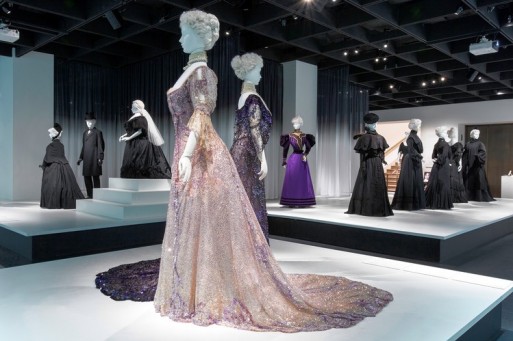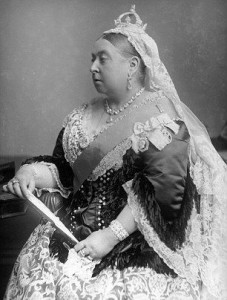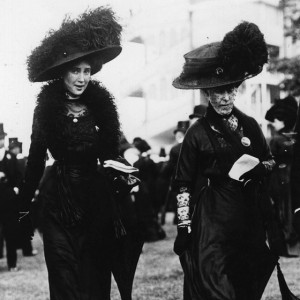
Victorian Mourning Attire
(credit: wsj.com)
“Death Becomes Her: A Century of Mourning Attire,” a current exhibit at the Metropolitan Museum of Art, is more than just a tour through the epoch of Victorian funeral fashion: It is a look at the changing stature of a woman in Western culture. Elaborate mourning rituals preserved the social order of the time and the Victorian widow was expected to become the reverent embodiment of grief. Some historians, however, argue that the Victorian women in mourning possessed a unique power. Contrary to the societal aim of focusing the widow on piety and devotion — a trend started by Queen Victoria after the death of her husband — the gowns from the second half of the Victorian era began to transition from coarse fabrics and prim styles into flowing dresses that emphasized tiny corseted waists and revealed bare shoulders and arms. Victorian widows indulged themselves by taking these dresses to the edge of conventions. In the words of Robert De Valcourt from “The Illustrated Manners Book” (1855), “Black is becoming: and young widows, fair, plump, and smiling, with their roguish eyes sparkling under their black veils are very seducing.”
Traditional mourning attire blazed a trail for the march of fashionable black and the little black dress. — Valerie Mendes

Queen Victoria in mourning
(credit: us.images.detik.com)
Death permeated life in the Victorian culture. Childbirth and common illnesses often killed family members early and at home. Detailed and sometimes morbid mourning customs, from postmortem photography to mourning emporiums, created an atmosphere that pandered to and flirted with death on a daily basis. While maintaining the proper mourning etiquette was often a financial burden to lower classes, many wealthy widows, no longer under the financial scrutiny of their husbands, thrived in that milieu. Independent yet available, virtuous yet sexually experienced, these Victorian women held an allure. While titillating the opposite sex with their mystique, they quietly subverted the image of formal propriety expected of a mourning widow.

A Victorian widow in mourning
(credit: static.squarespace.com)
“Death Becomes Her: A Century of Mourning Attire” displays mourning gowns and accessories from 1815 to 1915 and includes ensembles worn by Queen Victoria and Queen Alexandra. Arranged in chronological order, this exhibit shows the progression of fabrics from stiff crepes to sinuous silks, from somber black to hints of color. The show features about thirty gowned silhouettes set against a white background. Historic photographs and daguerreotypes reveal glimpses of Victorian life and death. The simple, modest dresses side by side with more flamboyant ones assert that black does not only signify Victorian widow as a devoted, gentle angel of the house but also as a sensual being.
While the pre-Victorian widow’s sexuality was expected to die together with her husband, Victorian convention only required a year of mourning in isolation, following which, these women, often wealthier after their losses, gained the ability of being more selective with their second husbands. The yearning for becoming clothing, whether as a distraction from grief, or an expression of vanity, brought the solemn black into light as chic and compelling. In the words of British writer Valerie Mendes, “Traditional mourning attire blazed a trail for the march of fashionable black and the little black dress.”
Black is becoming: and young widows, fair, plump, and smiling, with their roguish eyes sparkling under their black veils are very seducing. — Robert De Valcourt

 Death and the Birth of the Little Black Dress
Death and the Birth of the Little Black Dress


 “Other Side” Documentary Directed by Carter Oakley and Heather Hogan
“Other Side” Documentary Directed by Carter Oakley and Heather Hogan
 The Other Death in the Family
The Other Death in the Family















